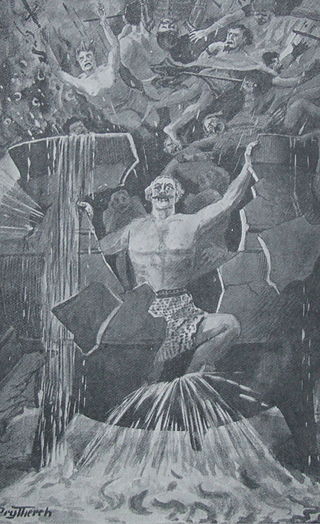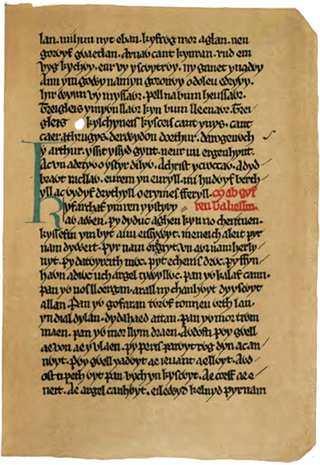Manawydan fab Llŷr is a figure of Welsh mythology, the son of Llŷr and the brother of Brân the Blessed and Brânwen. The first element in his name is cognate with the stem of the name of the Irish sea god Manannán mac Lir, and likely originated from the same Celtic deity as Manannán. Unlike Manannán, however, no surviving material connects him with the sea in any way except for his patronymic. Manawydan's most important appearances occur in the Second and Third Branches of the Mabinogi, but he is also referenced frequently in medieval poetry and the Welsh Triads.

Pryderi fab Pwyll is a prominent figure in Welsh mythology, the son of Pwyll and Rhiannon, and king of Dyfed after his father's death. He is the only character to appear in all Four Branches of the Mabinogi, although the size of his role varies from tale to tale. He is often equated with the divine son figure of Mabon ap Modron, while Jeffrey Gantz compares him to Peredur fab Efrawg, who is himself associated with the continental figure of Sir Percival de Galles.
Annwn, Annwfn, or AnnwfynAnnwvn, Annwyn, Annwyfn, Annwvyn, or Annwfyn) is the Otherworld in Welsh mythology. Ruled by Arawn, it was essentially a world of delights and eternal youth where disease was absent and food was ever-abundant. It became identified with the Lutheran afterlife in paradise.

Gwyn ap Nudd is a Welsh mythological figure, the king of the Tylwyth Teg or "fair folk" and ruler of the Welsh Otherworld, Annwn, and whose name means “Gwyn, son of Nudd”. Described later on as a great warrior with a "blackened face", Gwyn is intimately associated with the otherworld in medieval Welsh literature, and is associated with the international tradition of the Wild Hunt.

Branwen, Daughter of Llŷr is a major character in the Second Branch of the Mabinogi, which is sometimes called the "Mabinogi of Branwen" after her.

Efnisien fab Euroswydd is a sadistic anti-hero in Welsh mythology, appearing prominently in the tale of Branwen ferch Llŷr, the second branch of the Mabinogi. Described by Will Parker as "a study in the psychopathic personality" and an "embodiment of the forces of anti-social disruption," he is the catalyst of the tale's ultimate tragedy, and is largely responsible for the destruction of both Ireland and the Island of the Mighty. He is the son of Euroswydd and Penarddun, twin brother to Nisien, and half-brother to Brân the Blessed, Manawydan, and Branwen. The Welsh Triads call Llŷr one of the Three Exalted Prisoners of Britain for his captivity at Euroswydd's hands; this is likely to a lost tradition of the birth of Penarddun's younger sons.
Matholwch, King of Ireland, is a character in the Second Branch of the Mabinogi, the tale of Branwen ferch Llŷr.

Brân the Blessed is a giant and king of Britain in Welsh mythology. He appears in several of the Welsh Triads, but his most significant role is in the Second Branch of the Mabinogi, Branwen ferch Llŷr. He is a son of Llŷr and Penarddun, and the brother of Brânwen, Manawydan, Nisien and Efnysien. The name "Brân" in Welsh is usually translated as crow or raven.

Taliesin was an early Brittonic poet of Sub-Roman Britain whose work has possibly survived in a Middle Welsh manuscript, the Book of Taliesin. Taliesin was a renowned bard who is believed to have sung at the courts of at least three kings.

The Mabinogion are the earliest Welsh prose stories, and belong to the Matter of Britain. The stories were compiled in Middle Welsh in the 12th–13th centuries from earlier oral traditions. There are two main source manuscripts, created c. 1350–1410, as well as a few earlier fragments. The title covers a collection of eleven prose stories of widely different types, offering drama, philosophy, romance, tragedy, fantasy and humour, and created by various narrators over time. There is a classic hero quest, "Culhwch and Olwen"; a historic legend in "Lludd and Llefelys", complete with glimpses of a far off age; and other tales portray a very different King Arthur from the later popular versions. The highly sophisticated complexity of the Four Branches of the Mabinogi defies categorisation. The stories are so diverse that it has been argued that they are not even a true collection.
Cad Goddeu is a medieval Welsh poem preserved in the 14th-century manuscript known as the Book of Taliesin. The poem refers to a traditional story in which the legendary enchanter Gwydion animates the trees of the forest to fight as his army. The poem is especially notable for its striking and enigmatic symbolism and the wide variety of interpretations this has occasioned.
The Thirteen Treasures of the Island of Britain are a series of items in late-medieval Welsh tradition. Lists of the items appear in texts dating to the 15th and 16th centuries. The number of treasures is always given as thirteen, but some later versions list different items, replacing or combining entries to maintain the number.

Welsh mythology consists of both folk traditions developed in Wales, and traditions developed by the Celtic Britons elsewhere before the end of the first millennium. As in most of the predominantly oral societies Celtic mythology and history were recorded orally by specialists such as druids. This oral record has been lost or altered as a result of outside contact and invasion over the years. Much of this altered mythology and history is preserved in medieval Welsh manuscripts, which include the Red Book of Hergest, the White Book of Rhydderch, the Book of Aneirin and the Book of Taliesin. Other works connected to Welsh mythology include the ninth-century Latin historical compilation Historia Brittonum and Geoffrey of Monmouth's twelfth-century Latin chronicle Historia Regum Britanniae, as well as later folklore, such as the materials collected in The Welsh Fairy Book by William Jenkyn Thomas (1908).

The Book of Taliesin is one of the most famous of Middle Welsh manuscripts, dating from the first half of the 14th century though many of the fifty-six poems it preserves are taken to originate in the 10th century or before.
The Four Branches of the Mabinogi or Pedair Cainc Y Mabinogi are the earliest prose stories in the literature of Britain. Originally written in Wales in Middle Welsh, but widely available in translations, the Mabinogi is generally agreed to be a single work in four parts, or "branches." The interrelated tales can be read as mythology, political themes, romances, or magical fantasies. They appeal to a wide range of readers, from young children to the most sophisticated adult. The tales are popular today in book format, as storytelling or theatre performances; they appear in recordings and on film, and continue to inspire many reinterpretations in artwork and modern fiction.
Caer Sidi is the name of a legendary otherworld fortress mentioned in Middle Welsh mythological poems in the Book of Taliesin.

In Welsh mythology and literature, the Pair Dadeni is a magical cauldron able to resurrect the dead. It plays a key role in Branwen ferch Llŷr, the second branch of the Mabinogi. It is one of a number of magic cauldrons in Welsh legend and folklore, including the cauldron of Diwrnach the Irishman in Culhwch and Olwen, the cauldron of the Head of Annwn in Preiddeu Annwfn and the cauldron of Cerridwen in the tale of Taliesin.

Branwen ferch Llŷr; "Branwen, daughter of Llŷr" is a legendary tale from medieval Welsh literature and the second of the four branches of the Mabinogi. It concerns the children of Llŷr; Bendigeidfran, high king of Britain, and his siblings Manawydan and Branwen, and deals with the latter's marriage to Matholwch, king of Ireland. Matholwch's mistreatment of the British princess leads to a mutually destructive war between the two islands, the deaths of most of the principal characters, and the ascension of Caswallon fab Beli to the British throne. Along with the other branches, the tale can be found in the medieval Red Book of Hergest and White Book of Rhydderch. It is followed directly by the third branch, Manawydan fab Llŷr.
The nine sorceresses or nine sisters are a recurring element in Arthurian legend in variants of the popular nine maidens theme from world mythologies. Their most important appearances are in Geoffrey of Monmouth's introduction of Avalon and the character that would later become Morgan le Fay, and as the central motif of Peredur's story in the Peredur son of Efrawg part of the Mabinogion.
Prydwen plays a part in the early Welsh poem Preiddeu Annwfn as King Arthur's ship, which bears him to the Celtic otherworld Annwn, while in Culhwch and Olwen he sails in it on expeditions to Ireland. The 12th-century chronicler Geoffrey of Monmouth named Arthur's shield after it. In the early modern period Welsh folklore preferred to give Arthur's ship the name Gwennan. Prydwen has however made a return during the last century in several Arthurian works of fiction.








